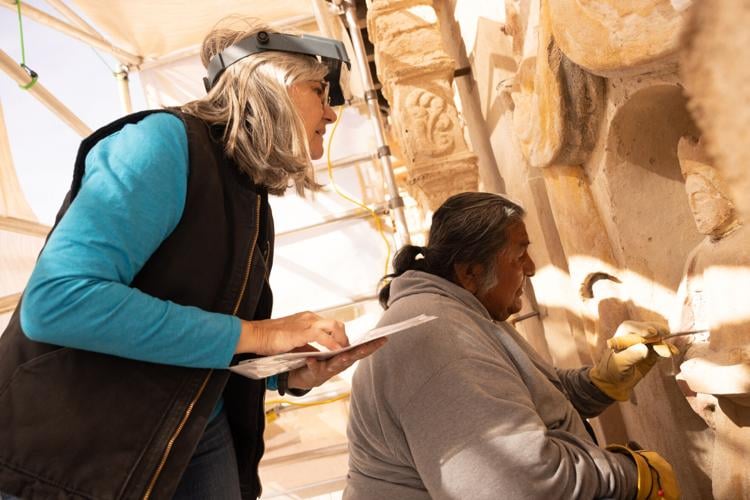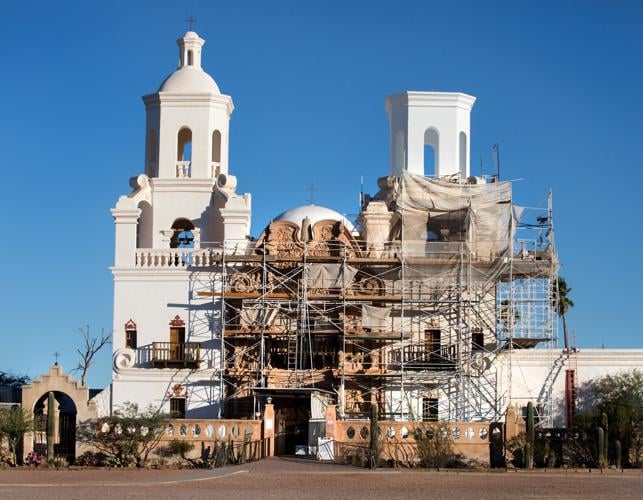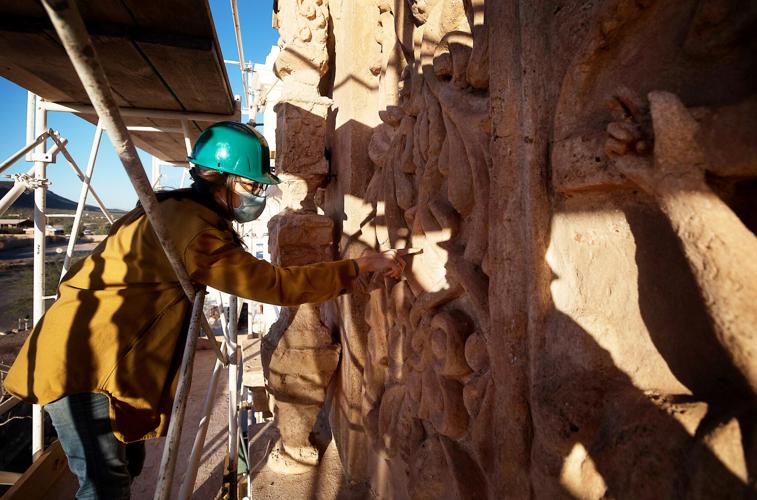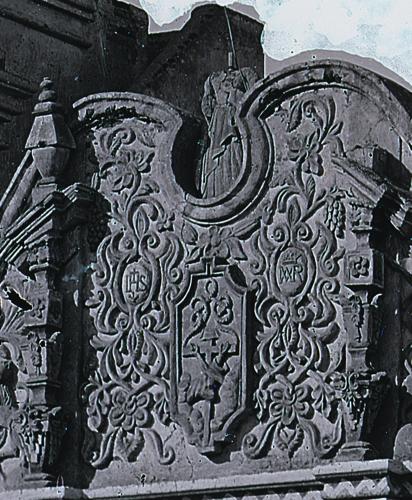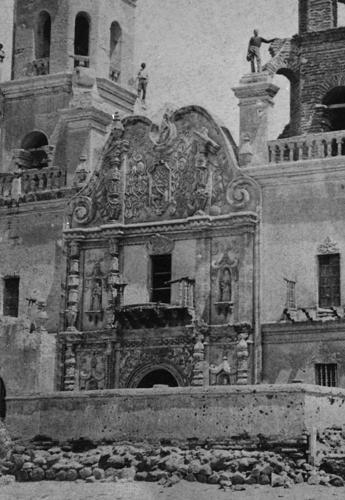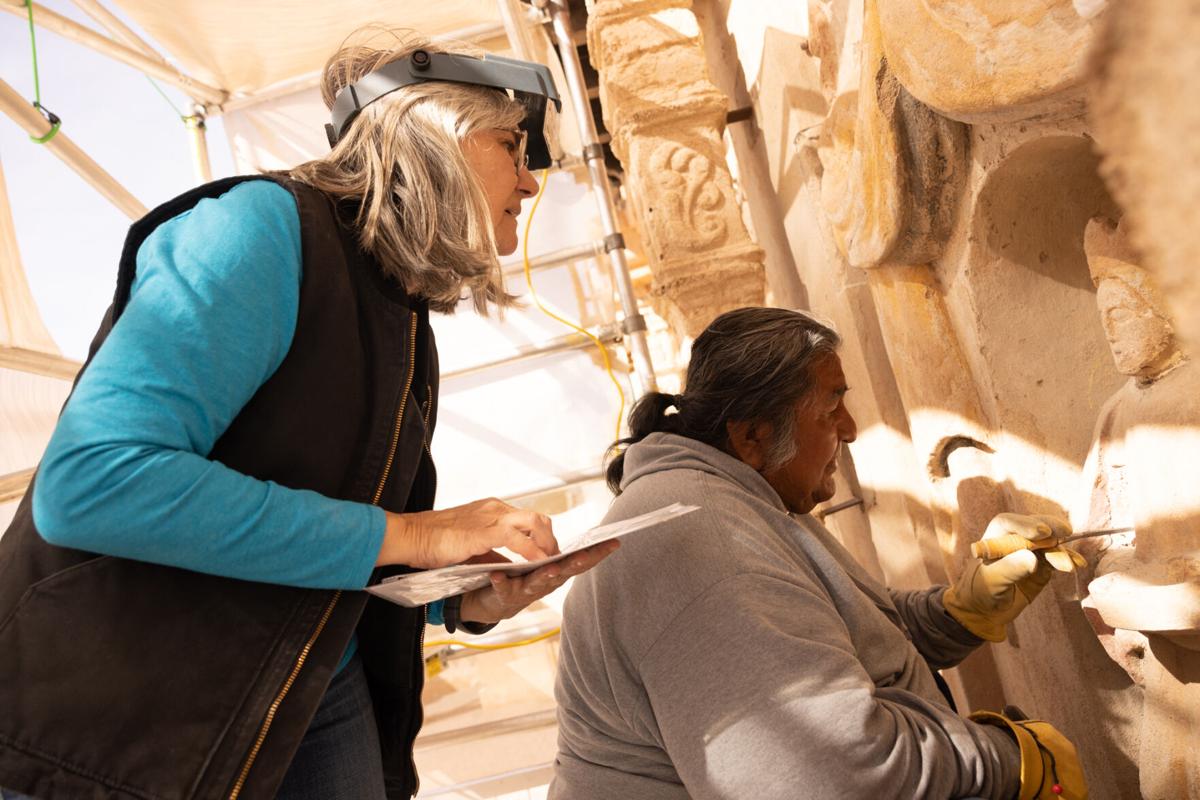The ornate entrance to San Xavier Mission will soon get a much-needed facelift, thanks to a $749,000 grant from the National Park Service.
Conservators for the late-18th-century church plan to spend the next two to three years carefully stabilizing and restoring the building’s decorative facade, which dates back to the late 18th century and features statues of five saints guarded by a pair of lions.

Scaffolding covers the front of San Xavier Mission during conservation work in 2021. The scaffolds are slated to return in October, as work begins to stabilize and restore the church’s decorative facade.
The Park Service announced funding for the project on Aug. 22 as part of its Semiquincentennial Grant Program, a multi-year initiative leading up to the 250th anniversary of the founding of the United States in 2026.
The grant-funded work at the mission should “help the church survive for another 200 years,” Park Service officials said.

Conservation workers in 1942 remove one of two surviving original columns from the facade at San Xavier Mission in a photograph from the George Chambers Collection at the Arizona State Historical Society.
It’s the single largest grant in the 46-year history of Patronato San Xavier, the nonprofit that oversees preservation and fundraising for Arizona’s oldest intact European structure.
“We’ve had some in the quarter-of-a-million-dollar range, but this one certainly beats the band,” said Patronato executive director Miles Green.
This will be the first large-scale restoration of the mission’s facade in more than 70 years. One of the primary goals of the project is to undo some of the damage done by that previous work.
During the 1940s and 1950s, San Xavier’s stewards covered the entire building, including the facade, with concrete plaster made from Portland cement in hopes of strengthening the structure and protecting it from the elements. Though the work was “thoughtfully done by the standards of that time,” Patronato officials said the plaster used back then ended up trapping moisture and damaging the centuries-old adobe material beneath it.
The first phase of the new project, set to begin in October, involves removing those “incompatible repair materials” and stabilizing the decorative surfaces to “retain as many of the original finishes and paint as we can,” said Starr Herr-Cardillo, conservation project manager for Patronato.
Careful copies
In future phases, the conservation team wants to reconstruct and replace key pieces of the facade that have been lost over time, including the decorative columns and the central mesquite-wood balcony.
The retablo surrounding the front doors of the church originally included 10 columns with distinctive designs, but the harsh desert climate — and a powerful earthquake in 1887 — gradually reduced them to rubble.
Only two columns remained by 1942, when they were wrapped in plaster jackets like the ones used to protect dinosaur fossils and removed for safekeeping. After 10 years in storage, though, the original material inside the jackets had dissolved into “a crumbly mess,” Herr-Cardillo said, so plaster forms were used to create the replica columns that are seen on the building today.
Patronato plans to use historic photos of the facade to create new, more accurate replicas of all 10 original columns.

A circa 1880 photograph shows the facade at San Xavier Mission.
Green said the project could also include preservation work on the church’s original wooden front doors, which date back to 1797 and are still in use today.
There is even some preliminary discussion of trying to recreate the statue of the church’s patron saint, which once graced the top of the facade before losing its head and torso and being modified into a flagpole decades later. But that idea could prove tricky, since the statue’s head was already missing when some of the earliest surviving photos of the mission were taken in the early 1870s.
Then there is the still-unsettled question of which patron saint once stood atop the church. Some scholars believe the statue depicted Saint Francis of Assisi, founder of the Franciscan order whose followers built the mission. Others are convinced it was Saint Francis Xavier, one of the original Jesuits for whom the mission is named.
If the statue ever was to be replaced, Green said, the decision about which Saint Francis could be left open to interpretation. “It may just be Frank,” he said.

Starr Herr-Cardillo, Patronato San Xavier’s conservation project manager, points out areas where cement patches were placed for repairs in the 1950s over the original facade at San Xavier Mission.
The Catholic church along the Santa Cruz River was constructed between 1783 and 1797 with kiln-fired adobe bricks and O’odham labor.
“The flags of four nations have flown over it,” Green said — Spain, Mexico, the U.S. and the Tohono O’odham Nation.
Because of the prominence of the facade, Patronato officials said all of the work on it is being done with caution, sensitivity and in consultation with church members and the surrounding community.
Slow going
Though many of the weathered or missing decorations on the front of the mission can’t be restored to their original appearance, Green said the conservation team hopes to “improve the legibility of the facade” overall so visitors can get a sense of what it might have looked like.
“There’s a lot of great photo documentation,” added Herr-Cardillo, but even that has its limits.
They simply don’t have enough detailed information to allow for a wholesale recreation of the original work. And even if they did, she said, they would never jeopardize what’s left of the historic material to attempt such a thing.
“I think it’s the job of any historian to be clear about what they know and what they don’t know,” Herr-Cardillo said.
As part of their final preparations for the restoration project, conservators spent about a month early this year cautiously removing the Portland cement from the lower section of Saint Lucy’s skirt in the alcove to the right of the mission’s front door.
The dress rehearsal, so to speak, focused on an area roughly the size of the front page of the Arizona Daily Star.
“We wanted to know how bad it is under there,” Herr-Cardillo said. “It was very eye-opening.”
During the 1950s restoration, workers nailed chicken wire to the original statue, coated it with a new layer of plaster and painted it using a color scheme that bore little resemblance to what had been there a century before.
Underneath that plaster, conservators found bits of the original paint, but removing the newer stuff to get to the old proved to be no easy task. “It was a helpful reality check in terms of how slow the work is going to be,” Herr-Cardillo said. “We’re going to have to proceed with caution in the heavily amended areas.”
The facade represents the last sizable patch of Portland-cement-based plaster left at San Xavier. The stuff has already been removed from the rest of the building and replaced with traditional lime-washed plaster mixed with cactus juice to allow the walls to breathe and dry out.
Ongoing mission
The restoration work will be done seasonally to lessen its impact on worshipers at San Xavier as much as possible. Herr-Cardillo said the scaffolding will go up in October and come down in March, clearing the way for Easter festivities at the church.
It’s too hot during summer to be working outdoors on the south-facing side of the building anyway, Green added.
The work is expected to last into 2026, but the exact scope and schedule for the project will depend on what the conservation team finds as it goes. “We don’t want to hem ourselves in with unrealistic expectations,” Green said.
Years of research, collaboration and outreach have already gone into the development of the restoration plan for the facade.
In 2021, scaffolding was erected in front of the church so the conservation team could perform the first-ever close-up inspection of the entire retablo.
Patronato had previously secured about $573,000 for the facade improvements, which are expected to cost approximately $1.4 million. The Semiquincentennial Grant grant should cover most of the rest, Green said.
In its announcement of the grant, the Park Service described San Xavier as “one of the finest examples of Mexican baroque architecture in the United States” and one of just a few mission churches in the country that is “still ministering to the descendants of the Indigenous community that built it.”
The historic site also draws more than 250,000 tourists each year.

Detail from a circa 1870 image by Timothy O’Sullivan shows the statue of St. Francis that used to stand atop the facade at San Xavier Mission.
San Xavier was among the first sites to be designated as a National Historic Landmark when the Park Service took over that program in 1960. The building was added to the National Register of Historic Places in 1966.
In 1700, Father Eusebio Francisco Kino put down the foundations for a church at the village of Bac, on the Santa Cruz River near modern Tucson, to be named after his patron saint, St. Francis Xavier.
As the new grant demonstrates, the White Dove of the Desert is more than just a place of local or regional significance, Green said. “It’s always been seen as a core piece of American history.”
Photos: San Xavier Mission in 1940 and 2015

Historic American Buildings Survey, Donald W. Dickensheets, Photographer. April 10, 1940 GENERAL VIEW MAIN CHURCH (SOUTHWEST ELEVATION). - San Xavier del Bac Mission. Photos from Survey HABS AZ-13

GENERAL VIEW MAIN CHURCH (SOUTHWEST ELEVATION). - San Xavier del Bac Mission, April 22, 2015. Photo by A.E. Araiza/ Arizona Daily Star

Historic American Buildings Survey, Donald W. Dickensheets, Photographer. March 27, 1940. NORTH ARCH TO SCHOOLYARD (NORTH ELEVATION). - San Xavier del Bac Mission. Photos from Survey HABS AZ-13

NORTH ARCH TO SCHOOLYARD (NORTH ELEVATION). - San Xavier del Bac Mission, Wednesday, April 22, 2015. Photo by A.E. Araiza/ Arizona Daily Star

Historic American Buildings Survey, Donald W. Dickensheets, Photographer. April 10, 1940. EAST TOWER THROUGH ARCH. (SOUTH ELEVATION OF CHURCH). - San Xavier del Bac Mission. Photos from Survey HABS AZ-13

EAST TOWER THROUGH ARCH. (SOUTH ELEVATION OF CHURCH). - San Xavier del Bac Mission, April 22, 2015. Photo by A.E. Araiza/ Arizona Daily Star

Historic American Buildings Survey, Donald W. Dickensheets, Photographer. March 27, 1940. LAST REMAINING ORIGINAL URN. EAST TOWER WALL. (NORTHWEST ELEVATION). - San Xavier del Bac Mission. Photos from Survey HABS AZ-13

LAST REMAINING ORIGINAL URN. EAST TOWER WALL. (NORTHWEST ELEVATION). - San Xavier del Bac Mission, Wednesday, April 22, 2015. Photo by A.E. Araiza/ Arizona Daily Star

Historic American Buildings Survey, Donald W. Dickensheets, Photographer. April 10, 1940. GENERAL VIEW - CHURCH AND PATIO (NORTHEAST ELEVATION). - San Xavier del Bac Mission. Photos from Survey HABS AZ-13

GENERAL VIEW - CHURCH AND PATIO (NORTHEAST ELEVATION). - San Xavier del Bac Mission, April 22, 2015. Photo by A.E. Araiza/ Arizona Daily Star

Historic American Buildings Survey Frederick D. Nichols, Photographer January 1938 DISTANT VIEW LOOKING NORTH. - San Xavier del Bac Mission. Photos from Survey HABS AZ-13

DISTANT VIEW LOOKING NORTH. - San Xavier del Bac Mission, Wednesday, April 22, 2015. Photo by A.E. Araiza/ Arizona Daily Star

Historic American Buildings Survey, Donald W. Dickensheets, Photographer. March 27, 1940. LANTERN OVER SACRISTY (NORTHEAST ELEVATION). - San Xavier del Bac Mission. Photos from Survey HABS AZ-13

LANTERN OVER SACRISTY (NORTHEAST ELEVATION). - San Xavier del Bac Mission, April 22, 2015. Photo by A.E. Araiza/ Arizona Daily Star

Historic American Buildings Survey, Donald W. Dickensheets, Photographer. March 29, 1940 NAVE OF CHURCH, LOOKING TOWARD HIGH ALTAR - San Xavier del Bac Mission. Photos from Survey HABS AZ-13

NAVE OF CHURCH, LOOKING TOWARD HIGH ALTAR - San Xavier del Bac Mission, Wednesday, April 22, 2015. Photo by A.E. Araiza/ Arizona Daily Star

Historic American Buildings Survey, Donald W. Dickensheets, Photographer. April 23, 1940. ANNUNCIATION - San Xavier del Bac Mission. Photos from Survey HABS AZ-13

ANNUNCIATION - San Xavier del Bac Mission, April 22, 2015. Photo by A.E. Araiza/ Arizona Daily Star


